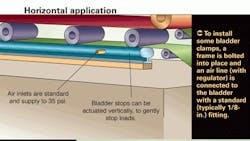Conveyors move discrete products down a line, but eventually those parts have to come to a stop. Here, traditional pneumatic and electromagnetic braking can be inefficient; stopping the line or grasping individual parts with grippers both require complex controls. Another approach is to install inflatable conveyor brakes or stops along the edges of a conveyor. When inflated, these elastomer bladders expand outward to catch and grasp parts in a gentle but secure manner. When deflated, they release parts and let them go by.
One typical application is for grasping irregularly shaped items. Bladder clamps are pliable and conform to such products, so are suitable for handling delicate bakery, curved optics and ceramics, and even heavy steel parts with unusual geometry. They also damp vibrations — helpful where brittle parts are handled.
To watch a video of this actuator in action, visit youtube.com and search for Pawling bladder. This month's handy tips provided by Craig Busby and Bob Paugh of Pawling Engineered Products, Pawling, N.Y.
Q&A
What are their drawbacks?
Which PWM motor-control IC is best for your application | Pulse width modulation is a form of signal communication that transposes a signal from analog to digital form. advertisement
Temperature is one consideration: The bladders should only be used for applications in which ambient conditions remain below 200° F. (Some bladders can withstand hotter temperatures, but these are not standard.) Inexact positioning is another issue. Bladder clutches can only hold items precisely if they're used to push items against a solid frame.
A final consideration is that bladder clamps can be punctured by very sharp objects. That said, some reinforced versions (available in custom or stock eight-inch sections) withstand gripping rougher parts, and last for more than 2,000,000 cycles through standard gaps — to extend two or more inches — and up to 35 psi, for higher forces.
Where else would an engineer use bladder clamps?
Besides stopping items on a conveyor belt, bladder clamps can be used to clamp pieces during bonding or cutting. Because they are made of rubber, they do not corrode or require contaminating lubricants, so can be used safely in food and packaging applications. Their nonsparking operation also keeps operations safe where there is a risk of fire or explosion; special conductive rubbers are available for additional protection against sparks.
Finally, bladder clamps are more compact than electromagnetic stops and arrays of mechanical clamps.
Can bladder clamps be designed for other arrangements?
The bladders described for conveying applications are typically standard footed bladders that operate at either 15 or 30 psi depending on fabric reinforcement.
Depending on the application, other bladder styles can be used. These include snap-in style profiles (for which the bladder snaps into a mating retainer) bladders manufactured in a circular configuration to grab round parts, or bladders manufactured with a nonstick coating to minimize frictional force.

